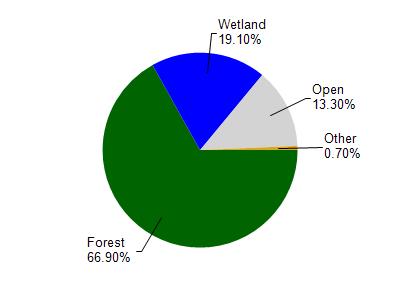Vilas
No
No
No
Fish and Aquatic Life
Overview
Fawn Lake T42n R05e S11 (Mud), in the Manitowish River Watershed, is a 69.88 acre lake that falls in Vilas County. This lake is managed for fishing and swimming and is currently not considered impaired.
Date 2011
Author Aquatic Biologist
Historical Description
Source: 1963, Surface Water Resources of Vilas County Fawn Lake, T-42-N, R-5-E, Sections 11 and 12,
Fawn Lake is a moderately-fertile drainage lake with slightly alkaline, clear water of moderate transparency. Bottom materials consist mainly of sand and gravel, with some rock also present. Fawn Lake is part of the Manitowish Chain and both the inlet and the Outlet streams are considered navigable. The muskellunge and walleye are the principal fish species; however, northern pike and largemouth are common. Public access is available to the lake either through navigable water access or by unimproved or difficult access. Commercial facilities consist of one resort with boat rentals and there are two cottages and/or dwellings on or about the lake shore. The lake is of little significance to fur bearers but does attract puddle ducks and diving ducks, as well as coots on the fall migration. The lake is also used as a nesting site by mallards, black, bluewing teal, and wood ducks, as well as by hooded mergansers.
Area = 66 Surface Acres, Maximum Depth = 16 feet
Date 1963
Author Surface Water Inventory Of Wisconsin
Condition
Wisconsin has over 84,000 miles of streams, 15,000 lakes and milllions of acres of wetlands. Assessing the condition of this vast amount of water is challenging. The state's water monitoring program uses a media-based, cross-program approach to analyze water condition. An updated monitoring strategy (2015-2020) is now available. Compliance with Clean Water Act fishable, swimmable standards are located in the Executive Summary of Water Condition in 2018. See also the 'monitoring and projects' tab.
Reports
Recommendations
Master Planning
This project will complete a Smart Growth compliant plan for the Township of Manitowish Waters. Specifically, this grant will cover portions of the agricultural/natural resources/cultural, internal governmental, land use, and implementation strategy elements.
Management Goals
Wisconsin's Water Quality Standards provide qualitative and quantitative goals for waters that are protective of Fishable, Swimmable conditions [Learn more]. Waters that do not meet water quality standards are considered impaired and restoration actions are planned and carried out until the water is once again fishable and swimmable
Management goals can include creation or implementation of a Total Maximum Daily Load analysis, a Nine Key Element Plan, or other restoration work, education and outreach and more. If specific recommendations exist for this water, they will be displayed below online.
Monitoring
Monitoring the condition of a river, stream, or lake includes gathering physical, chemical, biological, and habitat data. Comprehensive studies often gather all these parameters in great detail, while lighter assessment events will involve sampling physical, chemical and biological data such as macroinvertebrates. Aquatic macroinvertebrates and fish communities integrate watershed or catchment condition, providing great insight into overall ecosystem health. Chemical and habitat parameters tell researchers more about human induced problems including contaminated runoff, point source dischargers, or habitat issues that foster or limit the potential of aquatic communities to thrive in a given area. Wisconsin's Water Monitoring Strategy was recenty updated.
Grants and Management Projects
Monitoring Projects
| WBIC | Official Waterbody Name | Station ID | Station Name | Earliest Fieldwork Date | Latest Fieldwork Date | View Station | View Data |
|---|
| 2328900 | Fawn Lake | 643285 | Fawn Lake - Deep Hole | 9/4/1985 | 5/10/2022 | Map | Data |
| 2328900 | Fawn Lake | 10006408 | Fawn Lake | 8/29/2000 | 6/16/2025 | Map | Data |
|

Watershed Characteristics
Fawn Lake is located in the Manitowish River watershed which is 268.60 mi². Land use in the watershed is primarily forest (66.90%), wetland (19.10%) and a mix of open (13.30%) and other uses (0.70%). This watershed has 212.08 stream miles, 22,943.16 lake acres and 33,727.48 wetland acres.
Nonpoint Source Characteristics
This watershed is ranked Low for runoff impacts on streams, Low for runoff impacts on lakes and Low for runoff impacts on groundwater and therefore has an overall rank of Low. This value can be used in ranking the watershed or individual waterbodies for grant funding under state and county programs.However, all waters are affected by diffuse pollutant sources regardless of initial water quality. Applications for specific runoff projects under state or county grant programs may be pursued. For more information, go to surface water program grants.